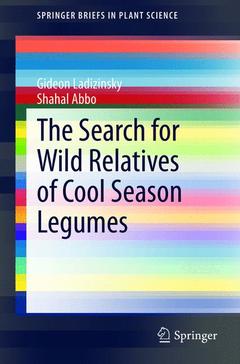The Search for Wild Relatives of Cool Season Legumes, 2015 SpringerBriefs in Plant Science Series
Auteurs : Ladizinsky Gideon, Abbo Shahal

Contents
1 The Lens Genus
1.1 Morphology and Taxonomy
1.1.1 Lens Morphology
1.1.2 Key to the Lens species
1.2 Description, Ecology and Distribution
1.2.1 Lens culinaris ssp. culinaris
1.2.2 Lens culinaris ssp. orientalis
1.2.3 Lens ervoides
1.2.4 Lens ervoides in Ethiopia and Uganda
1.2.5 Lens lamottei
1.2.6 Lens nigricans
1.2.7 Lens odemensis
1.2.8 Lens tomentosus
1.3 Genetics of Morphological Variation in Wild Lentils
1.4 Dwarfing Genes in the Genus Lens
1.5 Variation in Molecular Markers
1.6 Chromosome Variation
1.7 Crossability and Cytogenetic Relationships1.7.1 Genetic Nature of Hybrid Embryo Breakdown in the Genus Lens
1.8 The Wild Gene Pool of Lentil
1.8.1 Potential of the Wild Genetic Resources
1.9 The Species Concept
1.10 Lentil Domestication
1.10.1 Wild Lentil as a Food Source for Prehistoric Humans
1.10.2 The Mystery of Early Lentil Cultivation
1.11 Wild Genetic Stock of the Domesticated Lentil
2 The AnnualSpecies of the Cicer Genus
2.1 Taxonomy of Annual Cicer Species
2.1.1 Key to the Annual Cicer Species
2.2 Morphology of Annual Cicer Species
2.3 The Search for the Wild Progenitor of Chickpea
2.4 Distribution and Ecology of Other Wild Chickpea Annual Species
2.5 Crossability Relationships Among the Annual Chickpea Species
2.6 Economic Potential of Wild Genetic Resources of Chickpea2.7 The Mystery of Cicer canariense
2.8 Pathosystems of Ascochyta Blight in Chickpea and its Wild Relatives
2.9 Chickpea Domestication
2.9.1 Evidence for Introgression from Domesticated to Wild Chickpea
3. The Pisum Genus
3.1 Morphology and Taxonomy
3.1.1 Key to Pisum Species and Subspecies
3.2 Distribution and Ecology
3.2.1 Pisum fulvum
3.2.2 Pisum sativum ssp.elatius
3.2.3 Pisum sativum ssp. humile
3.2.3.1 Pisum sativum ssp. humile var. syriacum
3.2.3.2 Pisum sativum ssp. humile var. humile
3.3 Crossability and Species Relationships
3.4 Species Relationships in Pisum as Inferred from DNA Sequence Comparisons
3.5 Utilization of Wild Pisum Germplasm for Pea Improvement
3.5.1 Pisum fulvum
3.5.2 Pisum sativum ssp. humile
3.5.3 Pisum sativum ssp. elatius
3.6 Pea Domestication
4 Legumes with No Documented Genetic Relatives
4.1 Faba Bean
4.1.1 Chromosome Numbers and Karyotypes
4.1.2 Seed Protein Profiles
4.1.3 Crossability Experiments
4.1.4 Characterization of the Hypothetical Wild Progenitor of Faba Bean
4.2 Fenugreek
5 Fodder Crops
5.1 Vicia sativa, Aggregate of Common Vetch
5.1.1 Chromosome Variation and the Nature of Interkaryotypic Hybrids
5.1.2 Evolution of Vicia sativa Aggregate5.1.3 Economic Potential of Vicia sativa Wild Genetic Resources
5.1.4 Polyploidy in the Vicia sativa Aggregate
5.2 Vicia ervilia, Bitter Vetch
Brings together research findings that have been accumulated during the last 40 years, mainly by the authors, on wild relatives of cool season legumes
Indicates the wild relatives of lentil, chickpea, common and bitter vetch that can be exploited for breeding
Presents biological evidence that pulse domestication proceeded in a unique course, already in the wild
Includes supplementary material: sn.pub/extras
Date de parution : 04-2015
Ouvrage de 103 p.
15.5x23.5 cm
Disponible chez l'éditeur (délai d'approvisionnement : 15 jours).
Prix indicatif 52,74 €
Ajouter au panier


